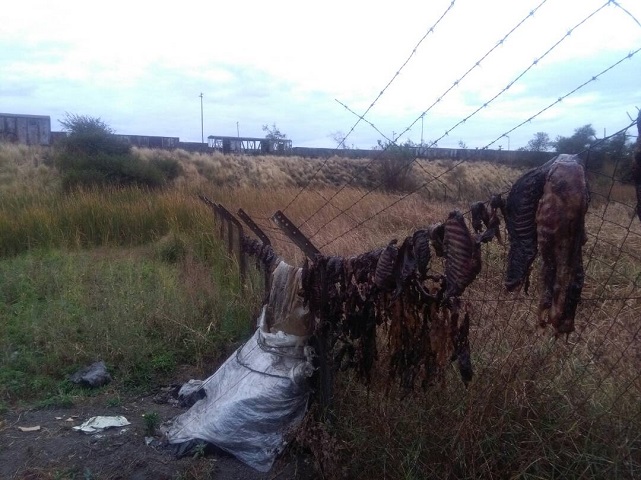Dog meat is not part of nation’s food culture


Dog carcasses hung out to dry near the NRZ Steam Shed in Bulawayo. A homeless man has been skinning dogs put down by the SPCA and selling the meat to residents
Saul Gwakuba Ndlovu
The recent arrest of a Bulawayo man on allegations of selling parts of dogs’ carcasses he retrieved from some rubbish dumping sites was a very unusual occurrence.
The dogs had been put down by the Society for the Prevention of Cruelty to Animals (SPCA) after they were found neglected and in a most pitiable condition.
In Bantu culture, dogs are kept mainly for two reasons: for protection of the owners and their property, and for hunting.
Hunting is still quite common in rural communities where meat from wild game supplements what is harvested from the fields or gardens, and what is purchased from commercial centres.
Collection of wild vegetables, fruits, edible roots, tubers, barks, wild honey and non-poisonous fungus such as some mushrooms may be done simultaneously with hunting by men, or on its own if women are involved in which case dogs do not play a part.
In communities where fishing is one of the food acquiring cultural practices, dogs do not feature. That is the case in all littoral states, and also in those countries where fishing is what agriculture is to other countries.
A Bulawayo-based veterinary department scientist commented negatively on the sale and possible consumption of dog flesh by Zimbabweans, saying it was not a part of the nation’s food culture. Nowhere do we come across how to prepare and cook a dog’s head in the history of Zimbabwe’s culinary culture.
In the case of goats, sheep or cattle, we teach our boys in their teens how to prepare the heads of those livestock for the pot, and tell them who eats which particular part.
Incidentally, the writer of this article is here referring to normal, traditional culinary practice, and not to what occurs especially in urban and quasi-urban communities in which omazakhela slaughter livestock, prepare and consume the heads themselves! Traditionally, heads were cooked and devoured by men only and not by women.
Probably that is an example of what students of cultural trends mean by the phrase: “Culture is dynamic and not static”.
To return to our relevant topic, the consumption of dog flesh, we find that the Bantu did not as a general practice eat the flesh of all canines, and dogs belong to that family (cannidae), to which also belong hyenas, wolves, foxes and jackals.
Although these carnivorous animals do hunt and devour their kill fresh, they also eat carrion, that is the putrefying remains of their kill. They are also virtually all scavengers, particularly hyenas and starving dogs.
That is one of the reasons human beings do not eat the flesh of those animals. Not even the San (BaKwa, the Inquas) who say they do not eat hyena flesh because those smelly animals consume dead people as well as anything that is flesh, never mind how rotten or rancid!
Incidentally, other things the San do not eat are baboons and monkeys because, they say, those animals’ facial features resemble those of human beings, so eating them would encourage cannibalism.
Meanwhile, it is interesting to note that as a general cultural practice, all Semitic races, that is to say all descendants of Shem the son of the biblical Noah, do not eat the flesh of animals that do not chew the cud. Semites are Arabs, Hebrews (Jews) Assyrians and Phoenicians.
Long, long ago Lemba people also avoided the flesh of all such animals. This article’s author is not aware that that tradition is still practised. However, traditional-minded Lembas do not consume the flesh of an animal they have not slaughtered themselves. It is difficult to imagine how they survived in today’s world which is a cultural global village.
Talking about the consumption of flesh by the Bantu (Banhu, Vanhu, Batho, Batru, aNtu etc) brings us to a most interesting aspect of the traditional food attitude of those people. They have totems (mitupo, izibongo) represented by either animals, birds, fish, reptiles or, in a few cases, plants or trees. Totemic animals, reptiles or trees were originally revered.
The totems range from such animals as the hare, (vundla, mutla, khuphe) to antbear (sambane, hhombela). Other animals that feature in totems are elephants (hhowu, ndlovu, nzou, zhou, tlou, ndou), eland (mhofu, impofu), cow, ox, (nkomo, tshuma), fish eagle (hungwe) dove (juba) goat (bhokwe) carnivore (sibanda, tjibanda, chibanda, shumba), gumbo, msipa (leg, foot, heal) moyo (heart) sibindi (liver), baboon/monkey (ncube), zebra (dube), snake (nyoka), calf (sithole), baobab (mbuyu, mkhomo), and acquatic creatures are fish (tlaping, hove), crocodile (ngwena, kwena, garwe, ngwenya) plus, of course, those whose totems are either the river (mlambo, gwizi) and pool (siziba).
Since totems were originally revered, the community that was identified by a particular totem treated their totemic object as taboo; they would not ride it or eat its flesh, or even use a kaross made of its skin or hide as a mat or cover, nor as sandals or a hat.
They attributed a living soul to their respective totemic objects, a clear aspect of animism in which those of the Ndlovu (nzou, hhowu, zhou, tlou, ndou) totem would neither eat the elephant’s flesh nor use its skin or hide in any way.
Those whose totemic objects were the carnivore would similarly avoid the flesh of lions, leopards, cheetahs, jackals, mongoose, cats and, of course, dogs.
However, very difficult circumstances changed that in and around what is now Lesotho when imfecane (difaqane) caused by Tshaka resulted in so much starvation that MaNtantisi’s people started to kill and eat their cats, horses and donkeys.
Social historians are not aware of the killing and consumption of dogs by those people during those extremely hard times. However, horses and cats are publicly slaughtered and their flesh eaten up too and including this very period.
In 1953, the writer of this article lived in Johannesburg’s Alexandra Township for a while. Opposite where he lived, at number 49 Dwelt, a BaSuthu family one of whose horses died because of something or other on the banks of the Jockskey River nearby.
He helped to skin it, after which very happily participated in a well-cooked horse stew, which he washed down with some semi-fermented BaSuthu maheu!
He is still very much alive and none the worse for that unforgettable experience.
That apart, the Bantu do not eat dog flesh probably because dogs have a much more important utilitarian hunting and security value than as part of a family’s menu.
Another reason could be that dogs generally become more emotionally attained to their owners than any other domestic animals. It is most unlikely that many of us would very happily slaughter our dogs for a meal or for a Christmas party.
The above reason is, however, overshadowed by what happens to dogs in other cultures, particularly in some far Eastern (Asian) countries where there are dog farms, and those animals are to their owners what goats or sheep are to us.
One could also attribute the non-consumption of dog flesh to culture and tradition in exactly the same way many people in some landlocked countries find it difficult to appreciate that fish is a staple food in all littoral nations.
Saul Gwakuba Ndlovu is a retired, Bulawayo-based journalist. He can be contacted on cell 0734 328 136 or through email. [email protected]









Comments